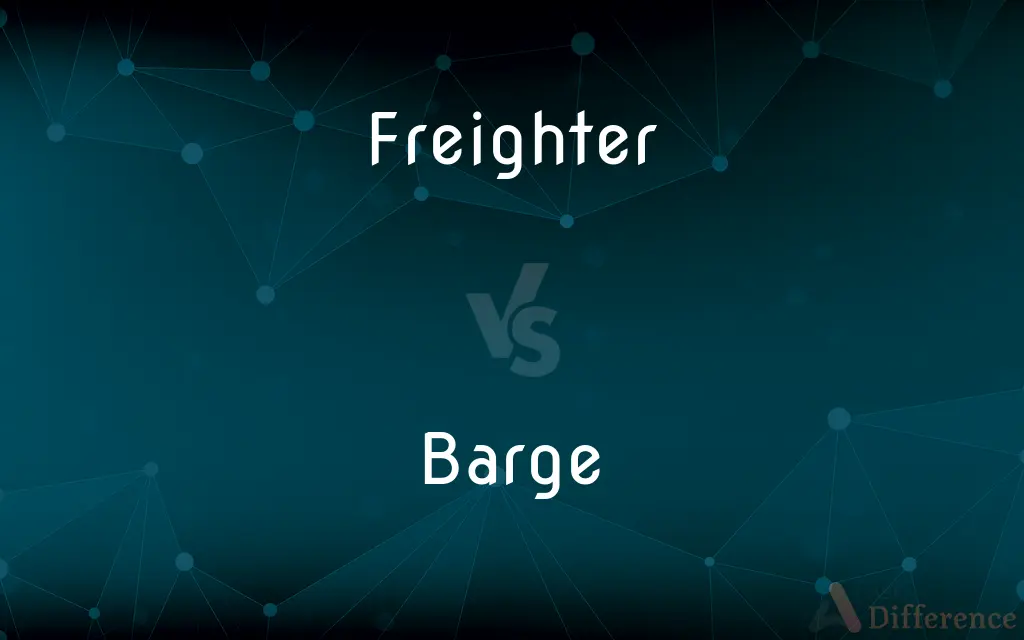Freighter vs. Barge — What's the Difference?
By Urooj Arif & Fiza Rafique — Updated on April 6, 2024
Freighters are large cargo ships for oceanic transport, while barges are flat-bottomed vessels for river or canal transport.

Difference Between Freighter and Barge
Table of Contents
ADVERTISEMENT
Key Differences
Freighters are large, ocean-going vessels designed to carry bulk goods or containers across seas and oceans. They are equipped with engines and navigational systems to traverse long distances independently. On the other hand, barges are flat-bottomed vessels primarily used for transporting goods through rivers, canals, and inland waterways. They often lack self-propulsion and require tugs or towboats to move.
While freighters are built to withstand the harsh conditions of open seas, including deep water and significant waves, barges are designed for the calm waters of inland waterways. This difference in operational environment dictates their respective designs; freighters have deeper drafts and enclosed holds, whereas barges have flat bottoms and open or covered holds to maximize cargo space.
In terms of capacity, freighters typically carry a larger volume of cargo, given their size and structural integrity. This makes them well-suited for international trade and long-distance transport. Barges, while having a smaller capacity, excel in transporting bulky or heavy goods short distances, especially where other modes of transport may not be economical or feasible.
The operation of freighters requires a skilled crew, including officers, navigators, engineers, and deckhands, to manage the complexities of maritime navigation and machinery. Conversely, barges, being simpler and often unpowered, require smaller crews and rely on towboats for navigation and propulsion.
The environmental impact of each vessel type varies. Freighters, due to their size and the distances they cover, have a significant carbon footprint, although advancements in maritime technology are aimed at reducing emissions. Barges are considered more environmentally friendly for short-distance transport, producing fewer emissions per ton-mile of cargo moved compared to other transportation modes.
ADVERTISEMENT
Comparison Chart
Environment
Oceanic and sea transport
Inland waterways like rivers and canals
Propulsion
Self-propelled with engines
Often requires tugs or towboats
Design
Deep draft, enclosed holds
Flat-bottom, open or covered holds
Capacity
Larger, for international trade
Smaller, suited for bulky or heavy short hauls
Crew and Operation
Requires skilled crew and navigators
Simpler operation, requires smaller crew
Environmental Impact
Higher carbon footprint
More environmentally friendly for short distances
Compare with Definitions
Freighter
Operates on international trade routes.
A freighter often travels thousands of miles to deliver goods.
Barge
Suited for transporting heavy or bulky goods.
Heavy machinery is often transported inland via barges.
Freighter
Designed for open sea conditions.
Freighters are equipped to handle rough ocean waves.
Barge
Has a flat bottom to navigate shallow waters.
The barge's flat bottom allows it to operate in shallow canals.
Freighter
Requires a professional crew for operations.
The freighter's crew includes experts in navigation and engineering.
Barge
Typically towed or pushed by a tugboat.
A tugboat pushed the barge through the narrow canal.
Freighter
Plays a vital role in global commerce.
Freighters transport a significant portion of the world's trade goods.
Barge
A flat-bottomed vessel for canal and river transport.
The barge carried coal along the river to the power plant.
Freighter
A large ship designed to carry cargo across oceans.
The freighter, loaded with containers, left the port at dawn.
Barge
Offers an eco-friendly transport option for short distances.
Using barges for short hauls reduces road traffic and emissions.
Freighter
A vehicle, especially a ship, used for carrying freight.
Barge
A barge is a shoal-draft flat-bottomed boat, built mainly for river and canal transport of bulk goods. Originally barges were towed by draft horses on an adjacent towpath.
Freighter
A shipper of cargo.
Barge
A long, large, usually flatbottom boat for transporting freight that is generally unpowered and towed or pushed by other craft.
Freighter
One who loads a ship, or one who charters and loads a ship.
Barge
A large, open pleasure boat used for parties, pageants, or formal ceremonies.
Freighter
One employed in receiving and forwarding freight.
Barge
A powerboat reserved for the use of an admiral.
Freighter
One for whom freight is transported.
Barge
To carry by barge.
Freighter
(nautical) A vessel used mainly to carry freight; a cargo ship.
Barge
To move about clumsily.
Freighter
An aircraft used mainly to carry freight; a cargo aircraft or cargo plane.
Barge
To intrude or interrupt, especially rudely
Barged into the meeting.
Freighter
One who loads a ship, or one who charters and loads a ship.
Barge
A large flat-bottomed towed or self-propelled boat used mainly for river and canal transport of heavy goods or bulk cargo.
Freighter
One employed in receiving and forwarding freight.
Barge
A richly decorated ceremonial state vessel propelled by rowers for river processions.
Freighter
One for whom freight is transported.
Barge
A large flat-bottomed coastal trading vessel having a large spritsail and jib-headed topsail, a fore staysail and a very small mizen, and having leeboards instead of a keel.
Freighter
A vessel used mainly to carry freight.
Barge
One of the boats of a warship having fourteen oars
Freighter
A cargo ship;
They did much of their overseas trade in foreign bottoms
Barge
The wooden disk in which bread or biscuit is placed on a mess table.
Barge
(US) A double-decked passenger or freight vessel, towed by a steamboat.
Barge
A large omnibus used for excursions.
Barge
To intrude or break through, particularly in an unwelcome or clumsy manner.
Barge
(transitive) To push someone.
Barge
A pleasure boat; a vessel or boat of state, elegantly furnished and decorated.
Barge
A large, roomy boat for the conveyance of passengers or goods; as, a ship's barge; a charcoal barge.
Barge
A large boat used by flag officers.
Barge
A double-decked passenger or freight vessel, towed by a steamboat.
Barge
A large omnibus used for excursions.
Barge
A flatbottom boat for carrying heavy loads (especially on canals)
Barge
Push one's way;
She barged into the meeting room
Barge
Transport by barge on a body of water
Common Curiosities
How do freighters and barges contribute to environmental pollution?
Freighters have a higher carbon footprint due to their size and fuel consumption, while barges are more environmentally friendly for short distances.
Are all barges unpowered?
Many barges are unpowered and require towboats, but some are self-propelled.
What types of cargo do freighters carry?
Freighters can carry a wide range of cargo, including containers, bulk goods, and vehicles, across global routes.
What is the capacity difference between a freighter and a barge?
Freighters can carry larger volumes of cargo over longer distances, while barges are used for smaller, heavy or bulky loads over short distances.
Can barges operate in the ocean?
Generally, barges are not designed for open sea conditions and are used in rivers, canals, and near-coastal waters.
What distinguishes a freighter from a barge?
Freighters are large, ocean-going cargo ships, while barges are flat-bottomed vessels for inland waterway transport.
Can freighters navigate inland waterways?
Due to their size and draft, freighters are generally not suitable for inland waterways and are confined to deep-water ports.
How do weather conditions affect freighters and barges?
Freighters are designed to handle adverse sea conditions, while barges are better suited to the calm waters of inland waterways.
Are freighters or barges faster?
Freighters, being self-propelled and designed for long distances, typically travel faster than barges.
How does cargo loading differ between freighters and barges?
Freighters use cranes and sophisticated loading systems for containers and bulk cargo, while barges are often loaded and unloaded with simpler equipment due to their open deck design.
How does the design of a freighter accommodate for its ocean journeys?
Freighters have deep drafts and enclosed holds to safely navigate and withstand the conditions of the open sea.
How do barges and freighters fit into the logistics chain?
Both are crucial for transporting goods; freighters for international trade and barges for inland distribution and short sea shipping.
What is required to operate a freighter compared to a barge?
Operating a freighter requires a skilled crew for navigation and machinery, whereas barges require less crew and rely on towboats for movement.
Can a barge carry passengers?
Some barges are designed or adapted to carry passengers, especially in tourist areas or as ferries.
What role do freighters and barges play in global trade?
Freighters are key to international trade, carrying goods between continents, while barges are essential for transporting goods inland, linking ports with inland destinations.
Share Your Discovery

Previous Comparison
Fulfilment vs. Requirement
Next Comparison
Recede vs. FadeAuthor Spotlight
Written by
Urooj ArifUrooj is a skilled content writer at Ask Difference, known for her exceptional ability to simplify complex topics into engaging and informative content. With a passion for research and a flair for clear, concise writing, she consistently delivers articles that resonate with our diverse audience.
Co-written by
Fiza RafiqueFiza Rafique is a skilled content writer at AskDifference.com, where she meticulously refines and enhances written pieces. Drawing from her vast editorial expertise, Fiza ensures clarity, accuracy, and precision in every article. Passionate about language, she continually seeks to elevate the quality of content for readers worldwide.
















































